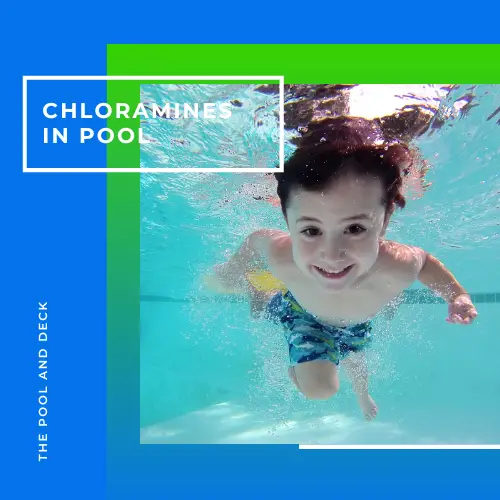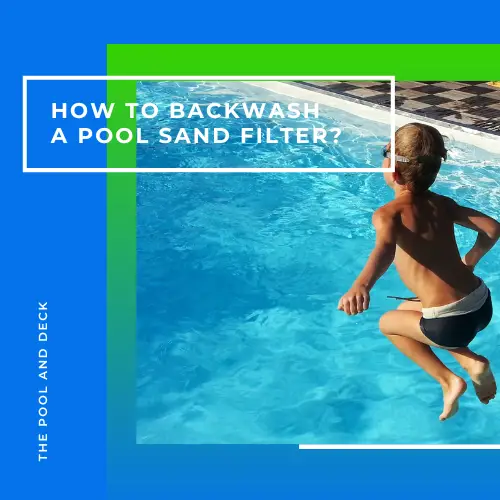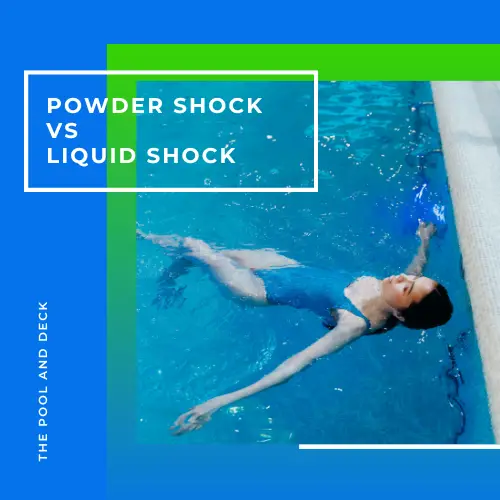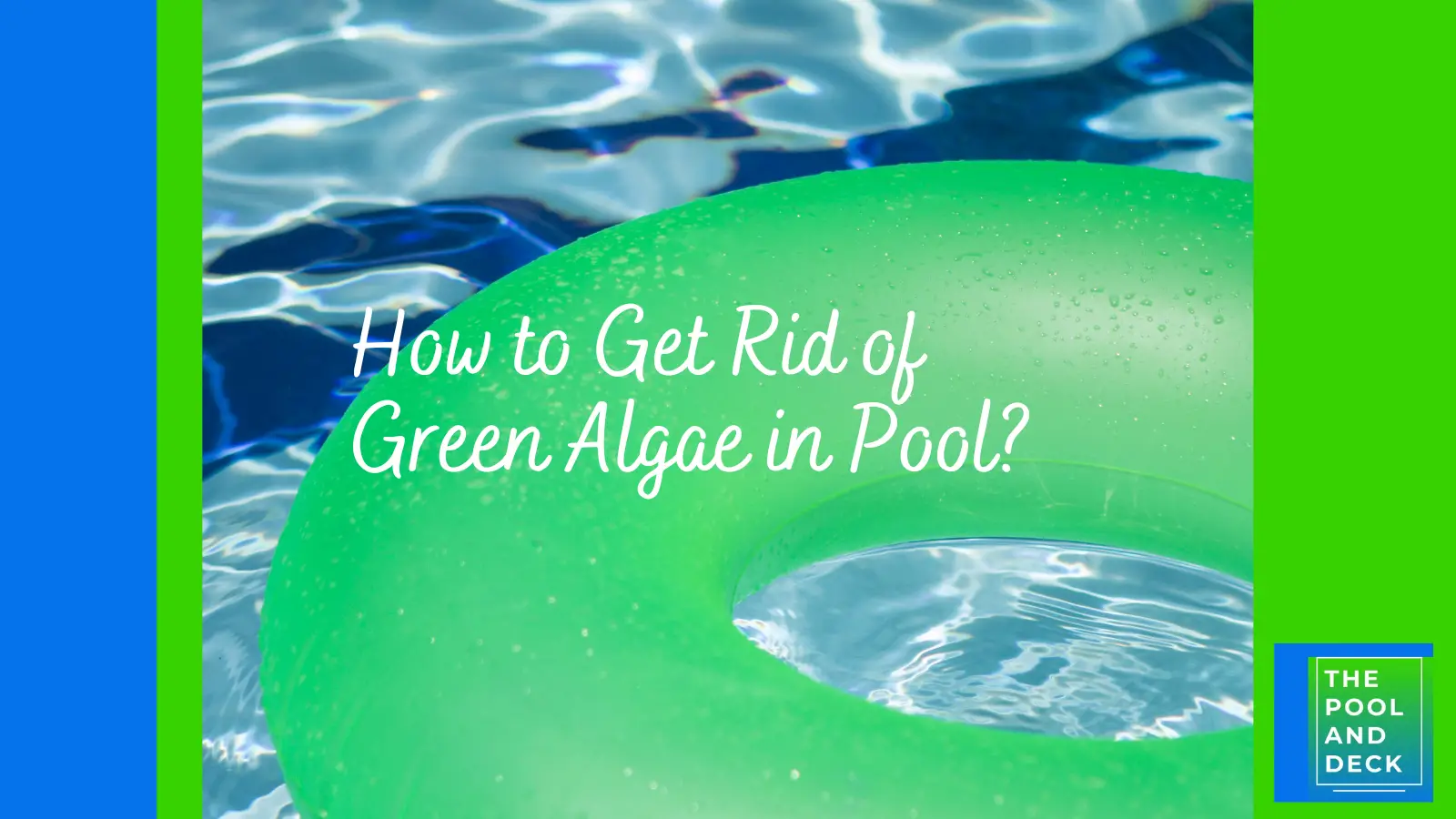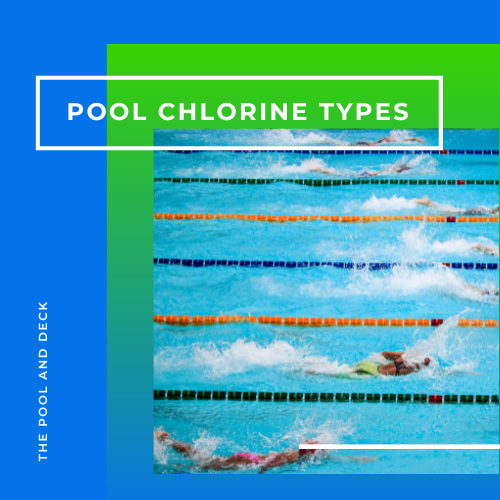Pool Alkalinity Too Low: Cause, Effect & Solution
As an Amazon Associate, I earn from qualifying purchases.
Table of Contents
Is Your Pool Alkalinity Too Low?
Is your pool alkalinity too low? Pool alkalinity needs to be within the recommended range.
The recommended range for pool alkalinity (aka Total Alkalinity) is 80 – 120 ppm.
KEY TAKEAWAYS
- Total alkalinity (TA) is a buffer and must be within the ideal range for maintaining pH stability and overall pool water balance.
- The recommended TA level is between 80-120 ppm.
- Test your pool water regularly to catch and correct imbalances early.
- Use baking soda (sodium bicarbonate) to raise alkalinity without significantly affecting pH levels.
- Use soda ash (sodium carbonate) when both alkalinity and pH need to be increased.
- Prevent low alkalinity by avoiding the overuse of acidic chemicals and using a pool cover during heavy rainfall.
- Properly balanced TA and pH ensure chlorine effectiveness and extend the life of pool surfaces and equipment.
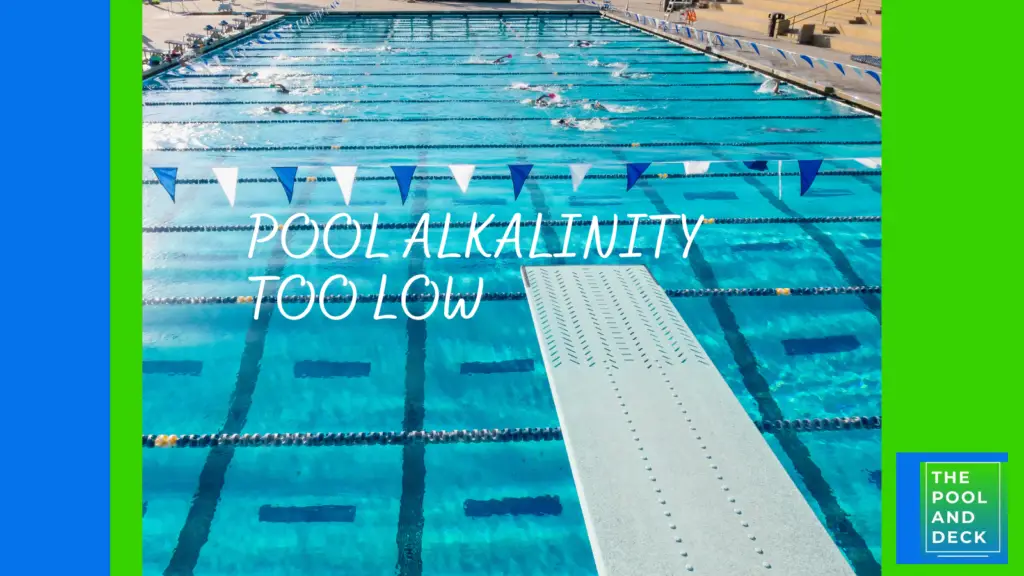
Both, pool alkalinity too high and pool alkalinity too low are not desirable conditions as they will have an adverse effect on the pH and pool water quality.
If you are a new pool owner, you may not be fully aware of the importance of having pool alkalinity too low. Truth be told, many experienced pool owners still get confused between alkalinity and pH.
New pool owners will benefit a lot by reading my earlier blog post, Pool Chemistry for Beginners: With 5 Super Helpful Cheat Sheets!
In this article, I will explain alkalinity and the importance of keeping pool alkalinity within the recommended range. The article will also answer the question, pool alkalinity too low: why and what to do?
What Is Pool Alkalinity?
The complete name for pool alkalinity is Total Alkalinity (TA). Total Alkalinity (TA) is the quantity of alkaline particles, mainly bicarbonates, in the water and is measured in parts per million (ppm).
Total Alkalinity and pH Relationship
Total alkalinity (TA) and pH levels are closely connected. Alkalinity acts as a buffer, stabilizing pool water pH. Think of TA as the stabilizer that keeps pH from swinging up or down too quickly.
The effectiveness of chlorine and other sanitizers, as well as swimmer comfort is a function of the pH level and indirectly the TA level.
Since, Total Alkalinity acts as a buffer, helping to stabilize and prevent rapid changes in pH levels, TA is, in a way, a measure of the ability of pool water to resist changes in pH.
When total alkalinity is too low, pH becomes unstable, leading to rapid changes often called pH bounce. For instance, you might notice the water becoming too acidic (low pH) or too basic (high pH).
Either extreme can cause problems like eye irritation, scaling, or corrosion of your pool surfaces and equipment.
On the other hand, if total alkalinity is too high, it can lock pH into a high range, making it difficult to lower it.
This is why maintaining the correct alkalinity is important—it prevents problems with both low pH in pools and high pH in pools.
If your pool’s alkalinity is balanced, your pH levels are more likely to stay within the ideal range of 7.4 to 7.6. The recommended range for Total Alkalinity (TA) is 80 – 120 ppm.
Maintaining pool alkalinity level within the recommended range prevents rapid pH fluctuations that can lead to corrosive or scale-forming conditions.
How to Test for Total Alkalinity in a Pool
Testing your pool’s total alkalinity (TA) is a simple but essential step in maintaining proper pool water balance.
Regular testing ensures that TA levels stay within the recommended range of 80-120 parts per million (ppm), helping to prevent low alkalinity or high alkalinity problems.
You can test for total alkalinity using:
- Test Strips: These are quick and easy. Simply dip a strip into the water, wait a few seconds, and compare the color change to the chart provided.
- Liquid Test Kits: These are more precise and involve adding reagents to a water sample to measure TA levels.
Collecting a Water Sample: Use a clean container to take a sample from about 12-18 inches below the pool’s surface.
Test Strips:
How to Use: Dip a test strip into the sample pool water for a few seconds, then remove it and wait for the colors to develop.
Reading Results: Compare the resulting colors on the strip to the color chart provided with the strips. This method is quick and convenient, making it ideal for regular checks.
Recommended Test Strips
JNW 7in1 Pool and Spa Test Strips
Simply dip the strip into the water for 2 seconds, hold strip horizontally for 30 seconds, and compare with the color chart on the bottle to obtain accurate water results in just seconds.
Liquid Test Kits:
How to Use: Collect a sample of pool water in a test tube. Add specific drops of reagents as instructed.
Reading Results: Observe the color changes in the sample. The intensity of these colors will indicate the alkalinity level. For total alkalinity, you may need to use additional reagents that specifically react to alkalinity.
For an even more sophisticated method use the one below.
Taylor Test Kit Method:
How to Use: Fill a comparator with 25 mL of pool water. Add two drops of R-0007 (thiosulfate) and swirl.
Then add five drops of R-0008 (total alkalinity indicator), which will turn the solution green. Finally, add R-0009 (sulfuric acid) drop by drop until the solution turns red, counting the drops.
Calculating Alkalinity: Multiply the number of drops used by 10 to determine total alkalinity in parts per million (ppm). The ideal range is typically between 80-120 ppm.
Recommended Chemical Test Kit
Taylor K-2005 Complete DPD 9-in-1 Test Kit
Tests for free & total chlorine, bromine, pH, total alkalinity, total hardness, and cyanuric acid (CYA) levels.
Tips for Accurate Testing
- Test your pool at least once a week, or more often after heavy rain or extensive use.
- Test both total alkalinity and pH levels together to ensure a balanced pool chemistry.
Regular testing helps you catch low alkalinity early and take the necessary steps to fix it. Consistent monitoring is key to maintaining a healthy and safe swimming environment.
What Causes Low Total Alkalinity in a Swimming Pool?
Alkalinity, like pH, is an important aspect of pool water chemistry. While they are distinct measurements, they are closely intertwined. A drop in pH can lead to a corresponding decrease in alkalinity.

In case pool alkalinity is too low, it could be due to one or more of the following 6 reasons:
- Rainwater Dilution: Rainwater, even regular rain, has a lower pH and alkalinity than pool water. When rainwater enters the pool, it dilutes the existing pool water, lowering its overall alkalinity. Acid rain, with its even lower pH, can have a more significant impact.
- Swimmer Influx: As the number of swimmers increases, so does the introduction of bodily fluids like sweat and urine. These substances contain acidic compounds that can contribute to a drop in pool alkalinity.
- Low Alkalinity Makeup Water: When replenishing pool water after vacuuming or filter backwashing, ensure the replacement water has adequate alkalinity. Using low-alkalinity water dilutes the existing pool water, lowering its overall alkalinity.
- Excessive Chlorine Disintegration: Certain chlorine sources, particularly di-chlor and trichlor, have low pH levels. If these chlorine sources disintegrate at a faster rate than recommended, they can release acidic byproducts that contribute to alkalinity reduction.
- Overuse of Acidic Chemicals: Frequent use of pH reducers like muriatic acid or dry acid can lower total alkalinity. While these products are effective for managing high pH, overuse can lead to unintended drops in TA.
- Water Evaporation: During hot summer months, pool water evaporation is natural. As water evaporates, it carries away dissolved carbon dioxide (CO2). CO2 contributes to alkalinity, so its loss leads to a decrease in pool alkalinity. This effect can be further exacerbated if the makeup water has low alkalinity.
- Water Agitation: Increased water movement, such as during pool parties or vigorous water games, can also lead to CO2 loss. The agitation enhances the release of CO2 from the water, resulting in a decline in pool alkalinity.
Effects of Low Alkalinity in Pool Water

When total alkalinity (TA) is too low, it can lead to a range of issues that affect your pool’s health, safety, and overall maintenance. Here is what you can expect when pool alkalinity is too low:
1. pH Instability (pH Bounce)
Low alkalinity means your pool water lacks the buffering capacity to stabilize pH levels. This can cause pH to fluctuate rapidly, leading to what is known as pH bounce.
Unstable pH makes it difficult to maintain proper pool water balance, creating ongoing challenges in keeping your pool safe and clean.
2. Corrosion of Pool Surfaces and Equipment
Low TA and low pH also result in increased corrosion of metallic parts in the pool equipment. Ultimately the pool ladders, pumps, filters, heaters, etc. will not last as long as they should.
Even plastic components such as vinyl liners, plumbing, pool covers, floats, etc get brittle. The result is a shorter working life if pool alkalinity remains too low for extended periods.
3. Reduced Chlorine Effectiveness
Low pool alkalinity impacts the efficiency of chlorine, the main sanitizer in your pool. When pH levels are unstable, chlorine becomes less effective at killing bacteria and maintaining clear water, putting swimmers’ health at risk.
Free Chlorine (FC) is more effective at lower levels. This is not necessarily a good thing, beyond a point, as the consumption of chlorine and the cost of pool maintenance goes up.
4. Swimmer Discomfort
Water with low alkalinity will result in low pH or high acidity. When pH drops below 7.2 your eyes will burn and your skin will be very dry after a swim.
Ensuring the TA level is within the recommended range is essential for swimmer comfort and health.
5. Algae and Cloudy Water
Unstable pH and ineffective chlorine due to low alkalinity can encourage algae growth and cloudy water. These issues can quickly escalate if left untreated.
How to Raise Alkalinity in a Pool
In case the Total Alkalinity level of your pool water is too low (below 80 ppm), you can fix it either by adding Baking Soda (Sodium Bicarbonate) or Soda Ash (Sodium Carbonate).
How to Raise Total Alkalinity Using Baking Soda
The most straightforward solution is to add sodium bicarbonate, commonly known as baking soda, to the pool water.
Baking soda is a readily available and affordable alkalinity increaser that gently raises alkalinity levels without altering other pool chemistry parameters.
Arm & Hammer Pure Baking Soda
America’s #1 Baking Soda Brand. Raises the total alkalinity level to ensure healthy swimming pool water. Helps prolong the life of pool surfaces and equipment.
Step 1: Test the Water
Use a test strip or liquid test kit to check your pool’s total alkalinity. If the TA is below 80 ppm, you’ll need to adjust it.
Step 2: Measure the Amount of Baking Soda
As a general guideline 23 oz of baking soda will increase the TA by 10 ppm in a 10,000 gallon pool.
You can use my Pool Baking Soda Calculator to determine the dosage for your pool.
Step 3: Add Baking Soda to the Pool
- Sprinkle the baking soda directly into the pool water.
- Distribute it evenly around the pool for best results.
- Avoid adding it to the skimmer to protect your equipment.
Step 4: Circulate and Retest
Run your pool pump for 4-6 hours to circulate the water. After 24 hours, retest the total alkalinity. If the level is still below 80 ppm, repeat the process in smaller increments.
Alternatively, commercial alkalinity increaser products are available in pool supply stores or online. These products are specifically formulated to raise pool alkalinity and may offer a faster and more concentrated solution compared to baking soda.
Pool Care Alkalinity Up
HTH 67060 Pool Care Alkalinity Up
Raises the total alkalinity level to ensure healthy swimming pool water. Helps prolong the life of pool surfaces and equipment.
How to Raise Total Alkalinity Using Soda Ash
Soda ash (sodium carbonate) is another option for raising total alkalinity, particularly if your pH levels are also too low. However, it’s more potent than baking soda and affects both TA and pH.
Step 1: Test the Water
Check your pool’s total alkalinity and pH levels. If both are below the ideal range, soda ash can help correct both issues simultaneously.
Step 2: Measure the Soda Ash
To raise TA by 10 ppm, add approximately 1 pound of soda ash per 10,000 gallons of water.
Step 3: Add Soda Ash to the Pool
- Dissolve the soda ash in a bucket of water before adding it to the pool to prevent cloudiness.
- Slowly pour the solution around the edges of the pool, avoiding the skimmer.
Step 4: Circulate and Retest
Run the pool pump for at least 6 hours. Test both the total alkalinity and pH levels after 24 hours.
- Soda ash raises pH more significantly than baking soda, so monitor it closely to avoid exceeding the ideal pH range of 7.4-7.6.
Soda ash is best used when both total alkalinity and pH need to be increased.
How to Get the pH Level Right After Raising Total Alkalinity
After raising total alkalinity, your pH levels may need adjustments to fall within the recommended range of 7.4 to 7.6. Here’s how to fine-tune the pH:
Step 1: Test the pH
Use a test strip or liquid kit to measure the current pH levels. Raising TA often increases pH, especially if you’ve used soda ash.
Step 2: Lower High pH with a pH Reducer
If the pH has risen above 7.6, use a pH reducer such as muriatic acid or dry acid:
- Follow the manufacturer’s instructions for dosage. You can also use my Free Muriatic Acid Pool Calculator!
- Dilute the product in water before adding it to the pool to ensure even distribution.
Step 3: Retest and Fine-Tune
Allow the water to circulate for 4-6 hours and test the pH levels again. Adjust incrementally to avoid overcorrection.
Preventing Alkalinity Imbalances in the Future
Once you’ve raised your pool’s total alkalinity (TA) to the ideal range of 80-120 ppm, maintaining balance becomes a regular task. Preventative measures can save you time and effort in the long run.
Here’s how to keep your TA levels steady:
1. Test the Water Regularly
Make testing a routine part of your pool care. Use a reliable test strip or liquid kit to monitor total alkalinity, pH levels, and other chemical parameters at least once a week.
2. Avoid Overuse of Acidic Chemicals
Be mindful when adding pH reducers like muriatic acid or dry acid. While these products help manage high pH, overuse can cause low alkalinity.
Always adjust in small increments and retest before adding more.
3. Protect Against Heavy Rainfall
Rainwater can dilute pool chemicals and lower total alkalinity. Use a pool cover during storms to prevent excess water from entering your pool. After a storm, test and adjust the TA levels if needed.
4. Maintain Proper Pool Maintenance Practices
- Keep your pool clean by skimming, brushing, and vacuuming regularly.
- Balance all chemicals consistently to prevent imbalances in TA and pH.
- Avoid adding large amounts of fresh water unless absolutely necessary.
5. Use an Alkalinity Increaser for Routine Adjustments
Even with careful maintenance, slight dips in TA levels can happen over time. Having an alkalinity increaser (such as baking soda) on hand allows you to quickly correct minor imbalances.
Frequently Asked Questions (FAQs)
What happens if total alkalinity is too high in a pool?
High total alkalinity can cause pH levels to remain excessively high, leading to cloudy water, scaling on pool surfaces, and reduced chlorine effectiveness.
To lower it, use a pH reducer like muriatic acid or dry acid.
Can I use baking soda to raise pH levels as well?
While baking soda can slightly increase pH, it’s primarily used for raising total alkalinity. If you need a significant pH boost, use soda ash instead.
How often should I test total alkalinity in my pool?
You should test total alkalinity weekly. Additionally, test after heavy rains, after adding large amounts of water, or if you notice cloudy water or irritated eyes.
What’s the difference between baking soda and soda ash?
Both are used to adjust pool chemistry. Baking soda (sodium bicarbonate) raises TA without a major impact on pH, while soda ash (sodium carbonate) raises both TA and pH levels.
Is it safe to swim in a pool with low alkalinity?
Swimming in a pool with low alkalinity can irritate the eyes and skin due to unstable pH levels. Always fix low TA before swimming.
Thank you very much for reading the post. I do hope you found it informative and helpful.





